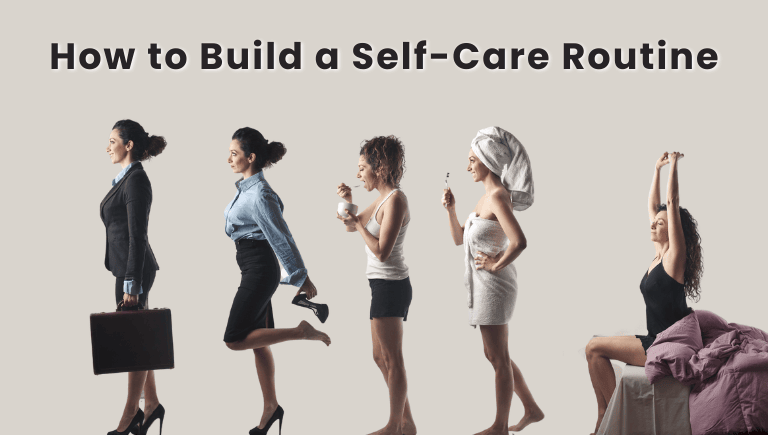How to Build a Self-Care Routine: We live in extra-stressful times and a self-care routine can be an invaluable tool to reduce anxiety, stress, and depression and improve happiness. Self-care doesn’t have to be expensive but it should be a priority.
A self-care routine can be as simple or complicated as you want but it should include the following: a) Improve your physical health.
Schedule it
The best way to establish a self-care routine is to start small and build upon it. Choose activities that fit your lifestyle, and set goals that are measurable, relevant, and within a reasonable timeframe. You may want to try something daily, like meditating or taking a warm bath, and then add something weekly, such as spending a day in nature or going out with friends, and finally something monthly, such as scheduling a massage.

Once you have your goals in place, pencil them into your calendar. If you’re struggling to find the time, consider reaching out to a mental health professional for support. BetterHelp has online therapists who can help you develop a personalized plan that fits your schedule and needs.
Make it a priority
Making time for self-care a priority can help you feel more relaxed and rested throughout the day. It can also increase your sense of well-being and boost happiness. However, it can be challenging to make this a habit in the beginning, especially if you are accustomed to putting your own needs last.
To get started, evaluate your current self-care habits and identify any areas that could be improved. Then, create a list of activities that fall into each of the four categories (mental, physical, spiritual, and emotional). Consider using the questionnaire from our previous post to help you identify activities that may be helpful.
Next, create a schedule for these activities and commit to them. Try to be consistent, but don’t worry if there are days you can’t stick with the routine. Ultimately, the goal is to develop a sustainable self-care routine that you can maintain even when life gets busy. The best way to do this is to start small with one or two activities, and then gradually build up your routine. For example, if you want to practice mindfulness meditation every day, try starting with 30 minutes.
Take a break
Incorporating self-care into your daily life can be easy if you set goals that are specific, measurable, realistic, and time-bound. Start by identifying your most important needs and brainstorm activities that will support them. “Then you can work on adding them to your routine one at a time,” Gill Lopez says. Make sure to add in something you can do every day, like meditating or taking a hot shower, along with something you can do weekly, such as spending quality time with family and friends or going on a hike, and then a long-term goal, such as scheduling a vacation.
Remember that it may take a while to build the habit of practicing self-care, and that’s okay. It’s also normal to struggle at times and it’s important to have support from a community that can cheer you on, as well as to be flexible and change your routine when necessary. “The most important thing is that you’re focusing on what works for you,” Gillihan says. “And that’s a highly individualized goal. You have to figure out what works for you.” And if you don’t feel the motivation, it’s ok to walk away and come back later.
Practice gratitude
A self-care routine is a series of habits that promote physical and mental health. These can include everything from prioritizing sleep to batch cooking healthy meals to engaging in mindfulness exercises or gratitude practice.
When planning your self-care routine, try to choose activities that make you feel happy and fulfilled. This is important, as the more enjoyable your self-care, the more likely you are to engage in it regularly. If you find that your self-care routine is starting to feel like a chore, consider changing it up or seeking professional help to deal with feelings of guilt and overwhelm.
For example, if you have been counting your blessings daily for months and find that it is no longer as effective, then try switching it up with a different activity or finding a buddy to keep you accountable (see Chapter 10 on the power of social support). You can also incorporate new activities into your routine as you become comfortable with them. For instance, if you have been practicing mindfulness for years but have never tried painting or bubble baths, then add those activities to your plan.
Invest in yourself
Investing in yourself can be done on many levels, including spending time on activities that interest you. Some examples include taking a class to learn a new skill, such as painting or drawing; working on your fitness; reading a book that will improve your understanding of the world around you; or pursuing a hobby, like cooking or gardening.
You can also invest in yourself by focusing on your emotional needs. This includes learning to listen and communicate with your feelings, as well as setting boundaries with others. For example, if you tend to give in to people too easily, making a self-care goal of practicing your ability to say no may help improve your quality of life.
Physical needs can be fulfilled by exercising, eating nutrient-rich foods, and maintaining hygiene habits. You can also invest in yourself by exploring hobbies, or even re-exploring old ones, as long as they make you happy. As you evaluate different ways to invest in yourself, remember that one size doesn’t fit all; find what works best for you! Creating a self-care routine takes time and commitment, but it’s worth it to foster your happiness.
